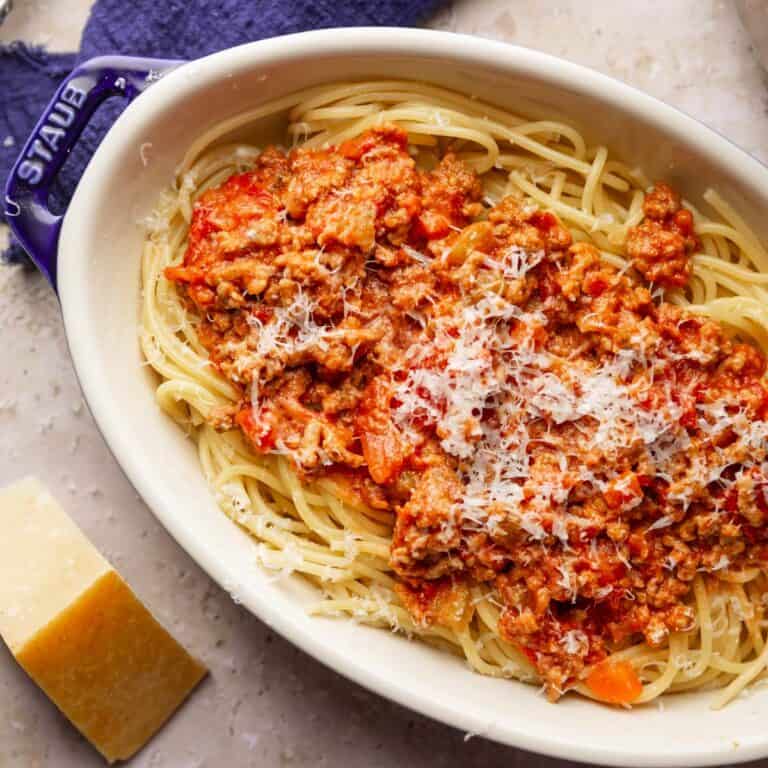
Homemade Bolognese sauce proves that good things come to those who wait. A low and slow cooking time transforms beef, pork, vegetables, and tomatoes into rustic, hearty meat sauce ideal for spooning over pasta or soaking up with crusty bread.

Cooking homemade Bolognese sauce from scratch, the traditional way, is an exercise in patience. As the sauce simmers low and slow, the ingredients meld together; the meat becomes tender and the tomatoes concentrate and deepen into a rich, complex base. The extended cooking process produces a depth of flavor that just can’t be rushed!
The result is an authentic, thick sauce that's perfect for a relaxed Sunday dinner with the family or for the holidays. Bolognese is also ideal for meal prep—make a large batch and you'll have a rich sauce ready to warm up and serve any night of the week.
Jump to:
- 🇮🇹 What is the difference between a bolognese and a ragu?
- 🍴What is bolognese traditionally served with?
- ❤️ Why I love this homemade bolognese sauce
- 🍅 Ingredient notes
- 📋 Substitutions and variations
- 🔪 Step by step instructions
- ⭐ Expert tips
- ⏲️ Make ahead and storage instructions
- 💭 Frequently asked questions
- 🥘 More homemade sauce recipes
- #ScarlatiFamilyKitchen
- Recipe
- Comments
🇮🇹 What is the difference between a bolognese and a ragu?
Just like how all squares are rectangles but not all rectangles are squares; Bolognese is a type of ragu, but not all ragu is Bolognese! Ragù is an Italian word that refers to any meat-based sauce. Ragù alla bolognese, or traditional Italian Bolognese sauce, is a meaty sauce that originated in Bologna, Italy.
Bolognese sauce is typically made with less tomatoes and white wine. Many ragu sauce recipes are made with red wine, more tomatoes and finished off with cream.
🍴What is bolognese traditionally served with?
Pasta Bolognese is one of the traditional ways to serve Bolognese sauce. I recommend choosing a shape that can hold this substantive meat sauce.
Tagliatelle, a broad, flat pasta, is a classic choice, but other options include spaghetti, pappardelle and fettuccine. Use rigatoni and penne if you prefer short pasta. For an extra special dish, learn how to make homemade pasta for your Bolognese.
Polenta is also great for serving this meaty sauce. You can serve it over a creamy polenta with parmesan or crispy fried polenta cakes.
Salad - A salad is always a good ideas to serve with heavier dishes like pasta alla bolognese. Try a classic Italian salad, seafood salad or simple arugula salad.
Bread - Serving pasta with bread is never a bad idea! It's great to mop up the extra sauce and let's be honest, when were extra carbs ever a bad idea? Try my homemade crusty Italian bread, homemade herb focaccia or braided pesto bread.
Vegetables - Like salad, having a side a veggies helps to balance out any meal. Try my grilled broccoli, roasted brussels sprouts or roasted artichokes with parmesan.
Dessert - Finish off this perfect meal with a delicious Italian dessert. Something light, such as lemon sorbet, individual tiramisu cups or strawberry panna cotta would be great!
❤️ Why I love this homemade bolognese sauce
Flavor - My favorite thing about this bolognese sauce is the richness that is developed from cooking all of the delicious, flavorful ingredients for a long period of time. The flavor that is created over time is one the of the best things.
Whole Family - This bolognese recipe is great for both kids and adults. Serve it for a family meal with confidence that everyone will love it!
Make Ahead - This sauce is perfect to make ahead. Depending on how much it reduces, it makes about 5-6 cups of sauce. Double the recipe and freeze for a lazy Sunday dinner later. Make sure to see my instructions below for storage.
🍅 Ingredient notes

- Meat – I use both ground beef and pork for my bolognese. The combination adds a ton of flavor and richness to the sauce. Ground veal and pancetta are also traditional options that work well in this Bolognese sauce recipe. You can add these in addition to the beef and pork, or use them instead of one or the other.
- Tomatoes – Canned whole peeled tomatoes add a bit of acidity and flavor. I recommend San Marzano Certified Tomatoes, as they have fewer seeds and a sweeter flavor.
- Beef Stock - Homemade beef stock will ensure an amazing depth of flavor for your sauce. I make mine in bulk and freeze for use in dishes such as this. Store-bought beef stock or beef broth is fine to use as well; make sure to select one with minimal preservatives or a low-sodium option.
- Wine – Dry white wine is best when cooking as savory dish like this—use Pinot Grigio, Chardonnay, or Sauvignon Blanc. Use extra beef stock if as a substitute if you prefer not to use wine. If you don't want to drink the leftovers, use it to make linguine with clams, french onion soup or chicken vesuvio.
📋 Substitutions and variations
- Dairy-Free – Use an unsweetened dairy-free milk alternative to make this a dairy-free Bolognese sauce. Since the milk adds richness, oat milk or soy milk work best.
- Gluten-Free – While this Bolognese sauce is naturally gluten-free, make sure to serve with your favorite gluten-free pasta and side dishes.
- Spicy – Add ½ teaspoon (or more!) of crushed red pepper flakes with the garlic to infuse your Bolognese sauce with some heat.
🔪 Step by step instructions
Heat a large dutch oven or pot over medium heat with the olive oil. Once the oil is shimmering, add the onions, celery, and carrots. Sauté for 3 to 5 minutes, or until the vegetables start to soften.
Stir in the garlic and sauté for 1 more minute, then add the ground meats, salt and pepper. Cook the meat, breaking it up with a wooden spoon, until it’s browned.

Stir in the whole milk and nutmeg and simmer for 2 to 3 minutes, or until the milk is almost absorbed. Next, pour in the white wine, stir, and simmer for 2 to 3 minutes, or until the wine is also almost absorbed.
Stir in the beef stock and whole tomatoes. Reduce the heat to medium-low and break up the tomatoes into smaller pieces using a wooden spoon.

Gently simmer the sauce for 3 hours, stirring occasionally, until it has reduced and is slightly thickened.
Serve over pasta or polenta, or cool and transfer to an airtight container for storage.

If you ever don't recognize a tool or skill that is mentioned, be sure to look it up in our Glossary of Cooking Terms and Definitions for more information.
⭐ Expert tips
- Cut the vegetables into a small dice so they melt into sauce as they cook down. Similarly, break the meat into small pieces while cooking. Bolognese sauce shouldn’t have large chunks in it.
- Use a heavy-bottomed pot or my favorite dutch oven pot to make Bolognese. Since it's simmering for a long time, you want to make sure your sauce is evenly heated and doesn't burn too easily or cook too quickly.
- Let the sauce simmer for at least 2 hours to develop the best flavor. Don’t rush the process or the flavor of the sauce will lack in flavor.
- Make sure that your sauce doesn't simmer rapidly. If the sauce simmers just gently, it will keep the liquid from evaporating too quickly.
- This Bolognese recipe yields approximately 5-6 cups, depending on how much it reduces. Plan for about ½ cup per serving.

⏲️ Make ahead and storage instructions
Bolognese sauce is great to make in bulk to store for an easy meal later. Make sure to cool it completely before storing, to avoid harmful bacteria from forming.
It will last about 3-5 days in the refrigerator, stored it in an airtight container. You can also freeze it in a large zip-top freezer bag for up to 3 months.
Defrost frozen sauce completely it in the refrigerator before reheating in a pot set over low heat. (If you need to loosen up the sauce a bit, add more broth, stock or tomato sauce.)
💭 Frequently asked questions
The key to building a delicious sauce is to layer the flavor. While it may seem like a lot of different ingredients to add to a sauce, each one plays an important part in the end result. Both the ground beef and pork as well as the addition of milk help to add richness to the sauce. Opt to use half and half or heavy cream for even more richness.
Milk in bolognese sauce adds both richness and creaminess to the finished sauce. It also helps to cut the acidity of the tomatoes as well as tenderize the meat.
Celery is part of a "soffritto" that is classic for a lot of Italian sauces and soups. An Italian soffritto is simply a combination of onions, carrots and celery that is sautéed in butter or olive oil for flavor.
🥘 More homemade sauce recipes
If you loved this homemade Bolognese sauce recipe, check out these other homemade sauce recipes that I know you will love too!
- Fresh Basil Pesto
- Sunday Italian Gravy Recipe
- Homemade Alfredo Sauce with Roux
- Hidden Vegetable Pasta Sauce
Recipe

Homemade Bolognese Sauce
Ingredients
- 1 Tablespoon extra virgin olive oil
- ½ cup diced yellow onions, approximately ½ medium
- ¼ cup diced celery, approximately 1 medium stalk
- ¼ cup diced carrot, approximately ½ medium
- 1 pound ground beef
- 1 pound ground pork
- 2 teaspoons kosher salt
- 1 teaspoon black pepper
- 6 cloves fresh garlic, minced (approximately 2-3 Tablespoons)
- 1 cup whole milk
- ¼ teaspoon ground nutmeg
- 1 cup dry white wine, Chardonnay, Pinot Grigio, or Sauvignon Blanc
- 1 cup beef stock, homemade or low-sodium
- 28 ounces canned whole peeled tomatoes, San Marzano certified if possible
Instructions
- Heat a large dutch oven or heavy-bottomed pot over medium heat on the stovetop with the olive oil.
- Once the oil shimmers, add in the onions, celery, and carrots and saute for 3-5 minutes until they start to soften.
- Add in the garlic and saute for 1 more minute, then add the ground meats, salt and pepper.
- Continue to cook the meat, while breaking it up, until it is no longer pink, about 4-5 minutes.
- Stir in the whole milk and nutmeg and let the mixture simmer for 2-3 minutes until the milk is almost absorbed.
- Stir in the white wine and then let the mixture simmer for 2-3 minutes until the wine is almost absorbed.
- Add the beef stock and whole tomatoes and stir everything to combine. Reduce the heat to medium-low and gently break up the tomatoes into smaller pieces with a spoon.
- Let the sauce simmer, very gently, for 3 hours, stirring occasionally, until the sauce has reduced and is slightly thickened.
- Serve over pasta or polenta, or cool and store for use later.
Notes
- Meat - Pancetta or ground veal can also be added.
- Wine - Instead of wine, extra beef stock may be added.
- Dairy-Free - Use an unsweetened dairy-free milk alternative.
- Gluten-Free - Serve with gluten-free pasta.
- Spicy - Add ½ teaspoon crushed red pepper flakes with the garlic.
- Storage - Cool the sauce completely and then store it in an airtight container in the refrigerator for 3-5 days or in a freezer bag in the freezer for up to 3 months. Defrost frozen sauce in the refrigerator. Reheat on the stovetop over low heat. Extra tomato sauce or stock can be added if needed.

 By
By 




Comments
No Comments